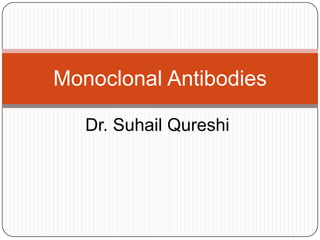
Monoclonal antibodies
- 1. Dr. Suhail Qureshi Monoclonal Antibodies
- 2. Journey so far… 1st generation of MAbs : limited effectiveness in trials Concerns : Imunogenicity & inefficient effector functions Murine origin Development of human antimouse antibody responses Engineered chimeric, humanized and fully human MAbs redefining cancer therapeutics
- 3. Monoclonal Antibodies Monoclonal antibodies (MAbs) are antibodies that are identical because they are produced by one type of immune cell, all clones of a single parent cell. Hybridoma technology (Kohler & Milstein ; Nobel prize winners 1984) made it possible to produce large quantities of antibodies with high purity and monospecificity for single binding region (epitope) on an antigen Antibody based conjugates employ targeting specificity of antibodies to deliver toxic compounds like chemotherapy drugs specifically to the tumour site
- 5. Immunoglobulin structure Fab domains mediate the binding of IgG to their cognate Antigens Each chain in the Fab domain has variable & constant regions Variable region contains the hypervariable or complementarity determining regions (CDRs) Ag contact residues reside in the CDRs The heavy & light chain variable regions each contain three CDRs (CDR 1, 2 &3) All 6 CDRs combine to form the antigen-binding pocket CDR3 plays a dominant role
- 6. Immunoglobulin structure Fab = Fragment, antigen binding Fc = Fragment, crystalline Fc domain : defines the different isotypes of immunoglobulins The Fc fragment specifies other biological activities of the molecule & determines how an antibody mediates its effector functions. For example, the Fc fragment may determine whether the antibody simply prevents signaling through a receptor, or causes the cell’s destruction through complement fixation or targeting immune effector cells.
- 7. Unfulfilled Promise? Early antibodies displayed insufficient activation of human effector functions (i.e. the antibodies did not kill the infecting organism or cell) Production of human anti-mouse antibodies (HAMA) Antigen distribution of malignant cells is highly heterogeneous, so some cells may express tumor antigens, while others do not. Tumor blood flow is not always optimal High interstitial pressure within the tumor can prevent the passive monoclonal antibody from binding. Insufficient tumour specificity of target antigens
- 8. Types of MAb designed Murine source: Rodent MAbs with excellent affinities & specificities, generated using conventional hybridoma technology. Clinical efficacy compromised by HAMA response, which lead to allergic or immune complex herpersensitivities. Chimeric : Chimers combine the human constant regions with the intact rodent variable regions. Affinity and specificity unchanged. Also cause human anti- chimeric antibody response (HACA) (30% murine resource) Humanized : Contain only the CDRs of the rodent variable region grafted onto human variable region
- 9. Evolution of Therapeutic Antibodies
- 10. Nomenclature of MAbs PRODUCT SOURCE IDENTIFIERS -e- -a- -i- -o- -xi- -zu- -u- Hamster Rat Primate Mouse Chimeric Humanized Human
- 11. Mechanisms of anti-tumour effects of MAbs Cell mediated cytotoxicity (ADCC-Antibody dependent cellular cytotoxicity) Complement dependent cytotoxicity Immunomodulation E.g. CTLA-4 Inhibitory receptor of T-cell activation Abs directed against CTLA-4Increase CD8+ & CD4+ immune response & induce tumour regression • Altering signal transduction (Bevacizumab-Anti VEGF)
- 12. Immunoconjugates Immunotoxins(Eg. BL22) Highly potent, Catalytic action, well defined biology & chemistry Drug Immunoconjugates (Eg. Gemtuzumab) Proven efficacy of antineoplastic component, well defined efficacy & toxicity, Bystander effect, Internalization not reqd Radioimmunoconjugates(Eg. Ibritumomab) Multiple available isotopes permit customized approaches, Internalization not reqd, Predictable toxicity based on dosimetry
- 13. Anti-tumour effects of MAbs
- 14. Unconjugated Antibodies approved for use in Solid tumours
- 15. Trastuzumab (Herceptin) Herceptin is an anti-cancer antibody that acts on HER2/neu (c-erbB-2) receptor, a member of the EGFR family which is overexpressed in 25% breast cancer. Only cells overexpressing this receptor are susceptible. Such cells, when treated with Herceptin, undergo arrest in the G1 phase of the cell cycle and experience a reduction in proliferation. This can reduce the rate of relapse of breast cancer by 50% during the first year in the adjuvant setting Combination with chemotherapy shows improved responses than chemotherapy alone Myocardial dysfunction seen with increased frequency
- 16. Cetuximab (Erbitux) Targets the EGFR & inhibits ligand induced activation of this tyrosine kinase receptor Approved for Colorectal Ca & Sq. Cell Ca of Head & Neck CRC : Combination of Erbitux with Irinotecan increased overall response & median duration of response as compared to Erbitux alone Patients with KRAS mutations in codon 12 or 13 should not receive anti-EGFR therapy
- 17. Panitumumab (Vectibix) Binds to EGFR with a higher affinity than Cetuximab Interferes with EGFR-Ligand (EGF, TGF α) interactions Setting : Metastatic CRC Patients with Metastatic CRC who have KRAS mutations in codon 12 or 13 should not receive this therapy
- 18. Bevacizumab (Avastin) Recombinant humanized monoclonal antibody against VEGF-A Approved in 2004 for use in combination therapy with 5- FU based regimens in the Rx of mCRC Other approvals: GBM (Prog.disease), Metastatic RCC (with IFN-α) and in combination with Pacli/Carbo for 1st line Rx of unresectable, locally advanced, recurrent or metastatic non-squamous, NSCLC Binds VEGF & prevents its interaction with its EC receptors (Flt-1) Side effects : Grade 3 HT, Grade 1 or 2 proteinuria, a slight increase in grade 3 or 4 bleeding & impaired surgical wound healing.
- 19. Rituximab Rituximab is a chimeric monoclonal antibody that targets the CD20 B-cell antigen. This antigen is expressed on 90% of B-cell neoplasms The precise biological functions of CD20 are uncertain, but the antibody is believed to function by flagging the B-cells for destruction by the body’s own immune system, including ADCC, CDC, and apoptosis. This antibody thus leads to the elimination of all B-cells from the body (including cancerous ones), allowing new, healthy B-cells to be produced from lymphoid stem cells.
- 20. Gemtuzumab ozogamicin (Mylotarg) This monoclonal antibody is conjugated to the cytotoxic agent calicheamycin It is used to treat relapsed CD33+ acute myeloid leukemia (AML), This monoclonal antibody attacks the CD33 receptor, which is found in most leukemic blast cells, but not in normal hematopoietic stem cells Represents the only FDA-approved immunodrug conjugate
- 21. THANK YOU